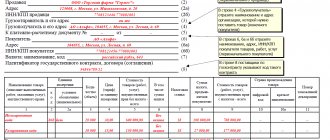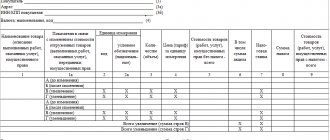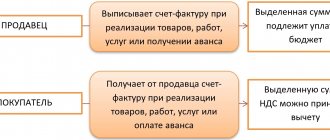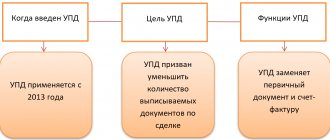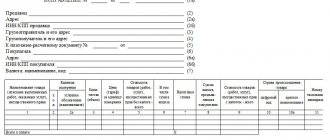Let's continue to understand the intricacies, ambiguities and subtleties of invoices: how and when to make corrections to an invoice, how a corrected invoice differs from an adjustment invoice, is it possible to accept an adjustment instead of a corrected one...
There are a lot of questions: what to take. when to reflect how tax liabilities are affected. The topic is hot. Current. Discussed and often commented on by controllers - the Ministry of Finance and the Federal Tax Service.
Shall we discuss?
So, if the supplier made critical errors in the invoice, he must correct them. In case they may be an obstacle to the buyer receiving a tax deduction. About significant and minor errors in the article “Damage invoice. Or suitable?
If critical errors are detected in the invoice, you must contact the seller to make corrections to the invoice. And your business partner must correct them.
How to correct errors on an invoice
Corrected is a new invoice with the correct data filled in line 1a. In essence, this is a clarified document.
Important: 1. Line 1 indicates the number and date of the invoice with errors.
2. Line 1a indicates the serial number and date of correction of the original (erroneous) invoice (“correction No. 1 dated “__”_____2019).
The remaining lines and fields are filled in as in the original invoice, but with the correct values.
The corrected invoice is drawn up in two copies: for both the buyer and the seller.
If a defective invoice was recorded in the purchase book (from the buyer) and in the sales book (from the seller), it should be canceled and a corrected one should be registered.
How is an invoice corrected?
After approval of Resolution No. 1137, correction of the invoice represents the execution of a document identical to the previously issued one, taking into account the following points:
- In paragraph 1 - the number and date of the invoice in which the incorrect data is established;
- In paragraph 1a - the number and date of amendments (the number is sequential, for the first correction - 1, for the second - 2, and so on in order);
- In the remaining fields, data is transferred from the source document with changes made to the incorrectly specified indicators.
Before the introduction of the new procedure for changing an invoice, the document had to be corrected by carefully crossing out incorrectly reflected information. The correct indicators were written next to them, the correction was certified with a signature and date.
Reflection of corrections in accounting and reporting
1. If the correction occurs in one quarter:
The seller cancels the entry for the erroneous invoice in the current period's sales ledger and records the corrected invoice. Cancellation will be carried out by re-registering the document in the sales book with negative indicators.
The buyer makes similar entries in his purchase book.
2. If an invoice drawn up in the previous period is corrected , then the seller and buyer make the same entries, but only in additional sheets to the sales book (purchase book) of the period in which the erroneous (initial) invoice was registered. And also two entries are made in the additional lists: the previous invoice is canceled and the corrected one is registered.
If, as a result of corrections, the final data of the sales book (purchase book) has changed, you must submit an updated declaration. And if the amount of VAT payable for the corrected period increases, you need to pay additional tax and penalties.
Symmetry is also important for minor errors.
It is possible that a cautious buyer will insist that the seller make a correction to the document even in the event of a minor error in the invoice.
Important: even if these are technical errors (number, date of the document, etc.), the seller must register the corrected document in the sales book. So that the corrected invoice information from the sales ledger is included in the tax return.
Otherwise, the ASK VAT-2 verification program will reveal a gap and the buyer will be denied a deduction.
Please note: the Ministry of Finance in letter dated May 6, 2021 N 03-07-11/32905 admitted that if the seller corrects an insignificant error (shortcoming), he may not register the invoice in the sales book. But in order to apply the deduction to the buyer, the mirror image of current invoices must be observed.
To be on the safe side, it is useful to request from the seller certified copies of the relevant sheets from his sales book.
Last quarter
The adjustment for the last quarter is processed in the same way as the correction account for the previous year . The basis for its creation are exactly the same errors as in the example above.
Such a document is drawn up by the taxpayer himself if he independently discovered the indicated errors (no penalties from the tax office will follow if such a corrected invoice is submitted).
This document is registered in the sales/purchase books in the same way, indicating the notes on the cancellation of the old account and entering new information with a “+” sign. Corrective invoices should be submitted to the tax service upon their completion. In this case, in addition to the invoice itself, you will also need to draw up an application for making changes .
Thus, in order to avoid possible violations and not lose the right to deductions, adjustment bills should be submitted on time, and for this you need to know the deadlines for submission and indicate accurate information in them. If errors in documents were discovered in past periods, a corrective invoice should be created and submitted to the tax office. In this case, no sanctions will follow from the service.
Such an unconventional UPD
If your counterparty uses a UTD (universal transfer document), be sure to make sure that the document received from him in the part in which it replaces an invoice:
- fully complies with the invoice format approved by current legislation,
- it contains all the necessary details,
- and they are indicated correctly.
The UPD form was approved 6 years ago by letter of the Federal Tax Service dated October 21, 2013 N ММВ-20-3/ [email protected] Since then, a lot of significant changes have been made to the rules for filling out invoices, approved by Resolution No. 1137. The UPD form is lagging behind. And no one is in a hurry to update it.
The Ministry of Finance and the Federal Tax Service in their letters advise independently supplementing the UPD, which combines the form of an invoice and a primary accounting document, with the indicators necessary to fulfill the requirements established by Article 169 of the Tax Code and the Rules for filling out an invoice used in calculations of value added tax , approved by Decree of the Government of the Russian Federation N 1137. (letters of the Ministry of Finance and the Federal Tax Service dated April 22, 2021 No. ED-4-15/7638, dated September 14, 2021 No. ED-4-15/18322.
Advice: if you use UTD, it is worth reworking its form, bringing it into line with the current invoice form. And fix the form of this primary document in the annex to the accounting policy.
If the seller has issued you an UTD, carefully check the document to ensure it corresponds to the current invoice form. And each of its details.
Otherwise, the tax office will cancel the VAT deduction based on the UTD using an outdated form with incomplete indication of details.
Correcting an error in an invoice should not be confused with the procedure for issuing a correction invoice.
For VAT purposes, correction of an error and adjustment are two completely different concepts. And it is necessary to clearly understand when it is necessary to correct a previously issued invoice, and when to prepare an adjustment for it.
When is the corrected invoice issued?
The concept of a corrected invoice is enshrined in Decree of the Government of the Russian Federation No. 1137 of December 26, 2011. This is a new independent document, which is issued on a separate form if there are errors that prevent the identification of key data from the original one, in such cases:
- When a document refers to the wrong date, month, or year.
- Incorrect indication of the taxpayer identification number, address, name and other details of the counterparties.
- Inaccurate indication of data for transfer of advance payment.
- Incorrect name and code of the currency used.
- If the name of the product, work or service is incorrectly identified.
- Incorrect cost of goods due to technical and costing errors.
- There is an error in the VAT rate and, as a consequence, in the overall tax result.
- For imported goods - incorrect code of the state that manufactured the goods, inaccuracies in the details of the customs declaration.
Reference. If the error in the invoice is insignificant and does not interfere with the recognition of the parties to the transaction, types of products, works or services, as well as the currency, rate and final amount of tax, then the right to deduct tax liabilities is retained (clause 2, clause 2, article 169 of the Tax Code RF).
These minor inaccuracies include:
- Numbering errors.
- Typos in the name of the organization (capital letters instead of lowercase letters, extra hyphens and commas).
- Inaccurate postal code.
- Incorrect definition of the code and symbol of units of measurement.
There is no more comprehensive list of imperfections in invoices in the legislation.
To draw up an amended form, counterparties do not need to enter into an additional agreement. It is issued in two copies in accordance with clause 7 of the Rules for filling out invoices, approved by Government Decree No. 1137.
The number and date in line 1 are transferred from the primary document, the correct columns remain unchanged, instead of erroneous data, the correct ones are written down, and in a special line 1a the number and date of the corrections are noted.
It is important to note that the preparation of such a document is possible not only for a regular shipping form, but also for an advance, adjustment and combined adjustment invoice (including several changeable forms).
The corrected copy is signed by the director and chief accountant of the company or directly by the individual entrepreneur.
On a note. The deadlines for issuing a corrected invoice are not defined in the legislation of the Russian Federation.
Also read about the adjustment invoice, namely how to make a reduction in the cost of goods or] how to post[/anchor] and how to reflect it in the VAT return.
Correction and error correction are two very different things
Completely different operations with completely different grounds, their own rules of documentation and reflection in accounting and reporting.
So, the adjustment conditions:
1.Adjustment - only if the cost changes.
An adjustment invoice is issued only when the cost of goods already shipped, work performed, services rendered, or transferred property rights is changed.
A change in price may be caused by:
- shortage of goods was detected,
- after shipment, the seller provided the buyer with a retro discount,
- sale of goods at a preliminary price with subsequent recalculation,
- changing the price in court at the request of one of the parties.
2. The adjustment must be formalized as a primary document. By which the parties agreed to reduce or increase the price of the product, or specified its quantity.
This may be a change (addition) to the contract, agreement, or other document confirming the fact of notification of a change in the terms of the transaction and confirming the buyer’s consent.
Important: The date of these documents must be later than the date of shipment. They confirm the fact that the change occurred after shipment.
Primary documents may be, for example, 1) an act on establishing a discrepancy in quantity and quality when accepting goods and materials in form No. TORG-2, 2) an act on price changes signed by the parties, 3) a court decision that has entered into legal force, and others
If there is no primary basis document, there is no need to issue an adjustment invoice. This is what the Ministry of Finance thinks in its letter dated February 9, 2021 No. 03-03-06/1/7833.
If, when issuing an invoice, inconsistencies or errors were initially made, including arithmetic, in value, in amount, such documents are not issued. Issuing an adjustment invoice in this case will be unlawful. To correct the error, a corrected invoice is issued.
Adjustment invoices: features and procedure for issuing them
When does the need to issue an adjustment invoice arise? This occurs in a situation of a justified change in the cost of goods shipped, work performed or services provided (clause 5.2 of Article 169 of the Tax Code of the Russian Federation). If you adjusted the price or changed the quantity of goods shipped, you cannot do without an adjustment invoice.
The basic requirements for invoices (for filling out information about the parties to the transaction, completing signatures, etc.) are described in Art. 169 of the Tax Code of the Russian Federation. In addition, the adjustment invoice requires the following conditions to be met:
- The adjustment invoice must be preceded by the buyer’s consent to change the cost and/or quantity of goods shipped (Clause 10, Article 172 of the Tax Code of the Russian Federation).
- An adjustment invoice must be drawn up no later than 5 calendar days after the above consent is issued (clause 3 of Article 168 of the Tax Code of the Russian Federation).
In addition, a special form is provided for the adjustment invoice. Its form is presented in Appendix 2 to Decree of the Government of the Russian Federation dated December 26, 2011 No. 1137.
You can download the current adjustment invoice form on our website using the link below.
Reflecting adjustments - according to your own rules
So, documents on changes in the value of previously shipped goods have been drawn up, the buyer’s consent to the change in value has been received, and an adjustment invoice has been issued.
The task is to correctly reflect the adjustment in accounting.
And the basic rules are:
- The accounting reflects the difference .
- The tax base of the current period . Regardless of the period in which the goods were shipped. The tax base calculated at the time of shipment is not subject to adjustment.
If the cost of shipped goods has increased, then in the current period (adjustment period):
- the seller includes the resulting difference in the tax base of the current period, regardless of the period in which the goods themselves were shipped;
- the buyer declares for deduction the difference between the VAT amounts calculated before and after the adjustment.
If the cost of shipped goods has decreased, then in the current period (adjustment period):
- the seller declares for deduction the difference between the VAT amounts calculated before and after the adjustment;
- the buyer recovers the VAT amount in the amount of the difference between the VAT amounts before and after the adjustment.
Some people remember that before 2013, adjustment invoices had to be registered in additional lists. Moreover, for the period when the shipment took place. This necessitated the submission of updated tax returns to the tax authority for the period of shipment of goods. Pay the difference in VAT and penalties.
As of July 1, 2013, this is no longer required. Now the differences that arise are reflected in the tax base of the current period . Therefore, the declarations do not need to be clarified, and no penalties will be charged.
How to reflect an adjustment invoice for a decrease in accounting
A change in the amount of tax billed upon initial shipment will entail the need for adjustments, including in accounting.
We will not dwell on situations with an increase in the sales amount: this is, in general, a standard situation in which, on the date of drawing up the adjustment invoice, the seller makes additional entries for the accrued VAT, and the buyer – for the deductible VAT.
In this case, it is worth dwelling on the question of how to carry out an adjustment invoice for a reduction. If the total amounts in the FSC turn out to be less than the initial ones, then the entries previously recorded in the accounting records must also be adjusted.
In this case, the seller will record the following entries in his accounting:
- REVERSE Debit 62 - Credit 90.1 - sales revenue is reduced by the agreed difference in the cost of goods, work or services;
- REVERSE Debit 90.3 - Credit 68 - accepted for deduction of VAT in the amount of the difference between the original and adjustment invoices
The buyer, after receiving the adjustment invoice for the reduction, will have the following postings:
- REVERSE Debit 20 - Credit 60 - the amount of debt to the supplier has been reduced;
- REVERSE Debit 19 - Credit 60 - reflects the difference in VAT on the original and adjustment invoices;
- Debit 19 – Credit 68 – the difference amount previously accepted for VAT deduction was restored.
The details have changed, what about the adjustment?
If, from the moment of initial shipment to the moment of adjustment, the basic details of the seller or buyer, for example, address, have changed. In this case, the adjustment invoice indicates new details - those that are valid at the time the adjustment invoice is issued.
Advice: when signing their agreement to change the price, it is advisable for the buyer and seller to clarify their details. If the obligation to notify about this is not fixed by the terms of the contract.
Results
After a shipment has already been made, it may be necessary to adjust the data on the quantity or price of goods sold in connection with reaching an agreement to change 1 of these indicators. In this case, an adjustment document is drawn up reflecting the original shipment data, their new value and the amount of change. Such a document is not used to correct errors made during registration.
Sources
- https://assistentus.ru/forma/schet-faktura/
- https://nalog-nalog.ru/nds/schetfaktura/obrazec_zapolneniya_korrektirovochnogo_scheta-faktury/
- https://nalog-nalog.ru/nds/schetfaktura/chto_takoe_korrektirovochnyj_schetfaktura_i_kogda_on_nuzhen/
- https://ppt.ru/forms/bolnichniy/korrektir-schet-factura
- https://pravovest-audit.ru/nashi-statii-nalogi-i-buhuchet/korrektirovochnyy-ili-ispravlennyy-schet-faktura-v-2021-godu-kak-ne-promahnutsya/
- https://101million.com/buhuchet/otchetnost/deklaratsii/nds/schet-faktura/korrektirovochnyj/korr-i-ispravitelnyj.html
- https://nalog-nalog.ru/nds/schetfaktura/kak_otrazit_korrektirovochnyj_schetfakturu_na_umenshenie/
- https://online-buhuchet.ru/kogda-ispolzuetsya-ispravlennyj-schet-faktura/
- https://www.klerk.ru/buh/articles/464542/
- https://nalog-nalog.ru/nds/schetfaktura/v_kakih_sluchayah_ispolzuetsya_ispravlennyj_schetfaktura/
About a single (consolidated) adjustment
The Tax Code provides for the possibility of generating unified (consolidated) adjustment invoices - invoices. Naturally, they were issued to the same buyer.
The seller can collect invoices that are subject to adjustment and enter data on them into a single adjustment invoice. At the same time, there will be only one adjustment invoice, and there will be only one entry for it in the books of the seller and the buyer.
Issuing a single adjustment invoice is not an obligation, but the right of choice of the seller . For some this is convenient. To reduce the number of documents and simplify accounting.
You can combine both options for issuing adjustment invoices - separate or single. There is no need to fix the choice option in the accounting policy.
A single adjustment invoice may indicate that the cost has increased for some items and decreased for others. In this case, it is necessary to separately summarize the data and reflect them separately in the final lines “Total increase (sum of lines B)” and “Total decrease (sum of lines D)”. The seller and buyer register such an adjustment invoice twice : in the purchase books and sales books, respectively.
How to simplify the process of filling out an adjustment invoice
Modern tools allow us to quickly find the necessary information, including filling out an adjustment invoice. However, it is important to understand that no matter how you formulate the request, the computer will produce many answers that will be difficult to navigate.
Will you enter into the search engine a general phrase like “adjustment invoice sample filling” (the option is incorrect, since the word “invoice” is masculine, but common) or a more precise “adjustment invoice sample fill 2021 (or 2021)” - it is not a fact that even the files proudly called “sample adjustment invoice 2021” obtained as a result will be reliable, especially in light of the fact that the form of the document has changed several times. As a result, the process of filling out an adjustment invoice may take longer.
Attention! When making changes to an invoice, you should use the form that was in effect on the date the original document was drawn up. For example, if the initial invoice was issued in September 2021, then to correct it you should use the form that was valid before 10/01/2017.
In order not to waste extra time searching for the necessary information related to issuing an adjustment invoice, it is better to follow the following algorithm:
- Study the current text of the main regulatory document regarding adjustment invoices (Resolution No. 1137).
- Download the current adjustment invoice form (for example, on our website).
- View a sample of filling out an adjustment invoice (also available in our document database).
- Create your own adjustment invoice based on them.
This procedure when preparing an adjustment invoice will allow you to take into account the requirements of the law and use the correct form of the adjustment invoice that is relevant for the given moment when filling it out.
Adjustment after adjustment
Adjustments to the cost of goods can be made repeatedly . In this case, for each subsequent adjustment, the seller issues an adjustment invoice to the buyer, which includes the data from the previous adjustment invoice. And it reflects the difference (increase or decrease) between them.
The number and date of the previous adjustment invoice are entered in line 1b of the subsequent (new) adjustment invoice.
A new adjustment invoice is also recorded in the current period for the amount of the difference. Entries on the previous adjustment invoice are not canceled and remain as they are in that period.
How long does it take for registration and delivery?
These documents must be submitted to the tax authorities in the same period in which they were issued. It is worth noting that if an adjustment invoice is issued at the border of periods, then in some cases the tax office refuses to accept it and may even issue a fine for issuing an invoice outside the due date.
However, such situations are quite often resolved by the court in favor of the payer, thanks to which it is possible to avoid a fine and receive the necessary deduction.
Return of goods
From April 1, 2021, returns of goods - both full and partial - are issued only with adjustment invoices.
Why: by government decree No. 15 of January 19, 2021, amendments were made to paragraph 3 of the Rules for maintaining the sales book, eliminating the obligation for the buyer to issue invoices for goods accepted for registration in the event of their return to the seller.
For the return of goods, the seller (!) must issue an adjustment invoice. It is he who will accept VAT for deduction on adjustment invoices.
The Ministry of Finance, in a letter dated April 10, 2021 No. 03-07-09/25208, warned: if, when returning goods accepted for registration, the buyer issues an invoice in the old manner, the seller will lose the right to deduction. Therefore, be careful!
Regarding the return, there is another letter from the Ministry of Finance dated April 8, 2021 No. 03-07-09/24636: if the return is formalized by an independently concluded purchase and sale (or supply) agreement, then VAT can be deducted on the invoice of the returning buyer product. In this case, in the contract, the original buyer must be the seller, and the original seller must be the buyer.
We correct again
In the event of a repeated change in the cost of shipped goods, the seller will have to issue a new adjustment invoice, into which the relevant data from the previous adjustment invoice is transferred (Letter of the Ministry of Finance of Russia dated 09/05/2012 N 03-07-09/127). For example, in line 1b of the new adjustment invoice, the number and date of the first adjustment invoice, for which the second adjustment invoice is drawn up, should be reflected, and in line A (before changes) of the repeated adjustment invoice, the information reflected in line B is transferred (after changes) of the previous adjustment invoice (Letter of the Federal Tax Service of Russia dated December 10, 2012 N ED-4-3 / [email protected] ).
Let's assume: the taxpayer indicated the number and date of the primary invoice in line 1b of the second adjustment invoice. These actions cannot become a reason for refusing to accept for deduction the amount of VAT on such an invoice. This is due to the fact that this error in the adjustment invoice does not prevent the tax authority from identifying the seller, the buyer of goods (work, services), property rights, the name of the goods (work, services), property rights, their value, as well as tax rate and the amount of tax presented to the buyer (paragraph 2, paragraph 2, article 169 of the Tax Code of the Russian Federation).
What happens if you issue an adjustment invoice instead of a corrected one?
Since the rules for registering adjusting and corrected invoices in the purchase books and sales books, as well as the procedure for applying tax deductions on them, are significantly different, both the buyer and the seller bear the risks.
Let's figure it out.
Yes, it’s possible that adjustments are convenient: you don’t need to plow through past periods, fill out additional sheets and prepare clarifications. In what period the document was received - in the same period it was reflected in the accounting.
But according to the rules established by law, an adjustment invoice can be issued subject to three conditions : 1) after shipment, the cost of the transaction changes 2) the parties have agreed on this 3) the primary document is available - the basis for the adjustment.
If one of the conditions is not met, the previously issued invoice must be corrected. Issuing an adjustment invoice will be illegal. And recognizing deductions on its basis is risky . The Ministry of Finance warned about this in a letter dated December 18, 2021 No. 03-07-11/84472. The same explanations are contained in numerous other letters from the controllers of the Ministry of Finance and the Federal Tax Service.
Seller's risks.
1. If, as a result of correcting the error, the cost of shipment has decreased - in the case of an incorrectly issued adjustment invoice - the seller faces refusal of a tax deduction for the amount of the difference between VAT, additional tax assessment, and penalties for tax liability for incomplete payment of tax.
2. If, as a result of correcting the error, the cost of shipment is increased - in the case of an incorrectly issued adjustment invoice - the seller faces additional tax, penalties and a fine due to underpayment of VAT for the shipment period.
3. For violation of the accounting procedure and the absence of corrected invoices, the seller may be brought to tax liability under Article 120 of the Tax Code and to administrative liability under Article 15.11 of the Code of Administrative Offenses for gross violation of the rules of accounting and taxation objects.
Buyer's risks.
If, as a result of correcting the error, the cost of shipment is increased , the buyer - based on an incorrectly issued adjustment invoice received from the seller - loses the right to deduct the positive difference between the VAT amounts in the period of making the adjustment.
Therefore, require the seller to correct errors by issuing corrected invoices rather than corrective ones. In compliance with the correct order of their reflection in accounting registers and tax reporting.
What to do with taxes?
The cost of shipped goods has increased
The seller must take such a change in the cost of shipped goods into account when determining the VAT tax base for the tax period (quarter) in which the corresponding goods were shipped (clause 10 of Article 154 of the Tax Code of the Russian Federation). It turns out that if you have already reported for that tax period, you will have to submit an updated tax return. The buyer in the described situation deducts the difference between the tax amounts calculated on the basis of the cost of goods shipped before and after such an increase (paragraph 2, clause 13, article 171 of the Tax Code of the Russian Federation). This deduction is made on the basis of adjustment invoices issued by the seller, in the presence of a document confirming the buyer’s consent (fact of notification) to the change in value, no later than three years from the date of drawing up the adjustment invoice (clause 10 of article 172 of the Tax Code of the Russian Federation).
Thus, the Tax Code establishes a special procedure for calculating the tax base by the seller and a procedure for applying deductions by the buyer in the event of an increase in the cost of shipped goods.
Reducing the cost of shipped goods
When the cost of shipped goods decreases, the seller applies a deduction in a special manner, and the buyer restores the amount of tax. From the seller on the basis of para. 1 clause 13 art. 171 of the Tax Code of the Russian Federation, the difference between the tax amounts calculated based on the cost of shipped goods before and after the reduction is subject to deduction. The procedure for applying the deduction is the same as for the buyer in the event of an increase in the cost of shipped goods (clause 10 of Article 172 of the Tax Code of the Russian Federation).
In the event of a decrease in the value of shipped goods, the “input” VAT previously accepted for deduction on these goods is subject to deduction in the manner established by paragraphs. 4 p. 3 art. 170 Tax Code of the Russian Federation. VAT amounts are subject to restoration in the amount of the difference between the tax amounts calculated on the basis of the cost of goods shipped before and after the reduction, in the tax period in which the earliest of the following dates falls:
- the date of receipt by the buyer of primary documents to reduce the cost of purchased goods (work performed, services rendered), acquired property rights;
- the date the buyer receives an adjustment invoice issued by the seller to reduce the cost of goods shipped.
Unreliable supplier
The carelessness or inattention of the supplier can seriously let the buyer down and leave him without a deduction.
More than once, businesses have tried to challenge in court the constitutionality of the provisions of the Tax Code, which make the taxpayer’s right to receive tax deductions dependent on compliance with tax legislation by its counterparties. But, unfortunately, the judges of the Constitutional Court of the Russian Federation did not find anything unconstitutional in these norms.
Russian judicial practice confirms that business liability is limitless. Checking potential counterparties is already a duty. With severe penalties for non-compliance: 1) accusation of complicity and 2) refusal to reduce the tax base and recognize deductions.
Of course, you can argue. But given the budgetary position of the courts, this is not always productive.
Therefore, it is important to calculate the risks and take timely measures to ensure the safety of your business. Be in the trend of current events. Know the tricks and understand the right moves.
In a fresh letter dated May 6, 2021 No. 03-07-11/32905, the Ministry of Finance once again warned that a corrected invoice that is not registered by the seller in the sales book deprives the buyer of the right to deduct VAT.
Making your legal right to a deduction dependent on the integrity or mood of the supplier is imprudent and risky. It's worth insuring yourself. It is useful to include in an agreement with a supplier - both a trusted partner and one chosen for the first time - a mandatory condition on the exchange of documents - the presentation by the seller of certified copies:
— additional sheets of the sales book (in case of correction of invoices) and
— current sheets of the sales book (in case of issuing adjustment invoices).
And further. It is advisable to include in contracts with suppliers other additional measures of responsibility that invigorate the counterparty. Eg:
- introduce a condition on a penalty for failure to submit properly executed documents within the established time frame: invoices, certified copies of sales book sheets and others;
- include in the contract a condition on assurances about the circumstances (in accordance with Article 431.2 of the Civil Code);
- stipulate in the contract the responsibility of the counterparty to compensate for property losses resulting from its violation of the law or obligations and guarantees under the contract. In this case, the contract must indicate the basis for compensation for losses;
and other useful conditions given in the article “Agreement with the counterparty. We manage risks."
If the counterparty is decent, he will not persist in accepting additional terms to the agreement. For him, these conditions do not entail any complications or problems.
If the counterparty avoids submitting documents or refuses to sign the proposed version of the contract, this is a reason to think about the reasons for his opposition and evaluate the advisability of choosing this particular counterparty to execute the contract.
If an unscrupulous seller delays in submitting documents, additional liability measures will help recover damages from him in a civil dispute. Without waiting for a tax audit and its results.
